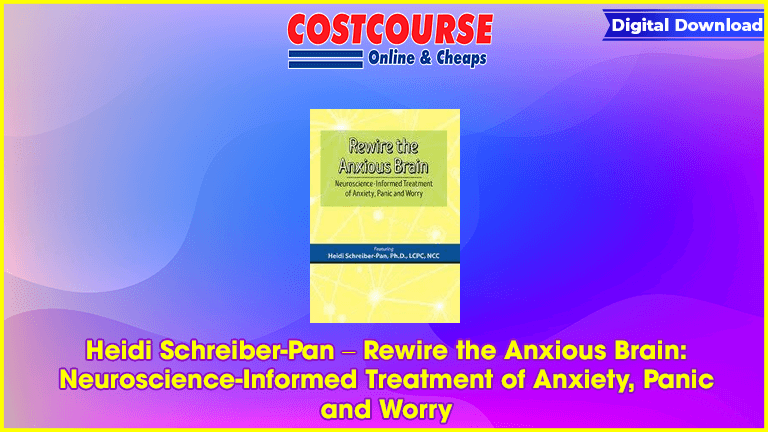Description
Join Dr. Heidi Schreiber-Pan in this recording, and learn her keys for successful anxiety treatment. Dr. Schreiber-Pan integrates brain-based strategies for calming the anxious mind with client communication techniques that motivate change in your clients.
Heidi Schreiber-Pan – Rewire the Anxious Brain: Neuroscience-Informed Treatment of Anxiety, Panic and Worry
Heidi’s approach promotes adherence to treatment and strengthens the therapeutic alliance – which is essential when working with anxious, worried, traumatized, or obsessive clients. Dr. Schreiber-Pan will give you tools and techniques to:
Identify and treat the roots of anxiety in both the amygdala and the cortex
Explain “the language of the amygdala†in an accessible, straight forward way
Identify how the cortex contributes to anxiety, and empower clients with strategies to resist anxiety-igniting cognitions
Purchase this transformational workshop and put the power of neuroplasticity to work for you and your anxious clients!
Handouts
Manual – Rewire the Anxious Brain (14.8 MB)
72 Pages
Available after Purchase
Outline
Use Neuroscience in the Treatment of Anxiety
Positives:
We know more about anxiety-based disorders than any other disorders
Science gives explanations, evidence, authority, destigmatizes difficulties
Concerns:
It can be difficult to explain, answer questions
Clients may feel a lack of responsibility
Oversimplification is inevitable
Enhancing Engagement in Treatment
Don’t neglect the therapeutic relationship!
Address the challenges of anxious clients
Remember that strategies are effortful
Guide the process using client’s goals
Maintain motivation
Neuroplasticity
Define Neuroplasticity in everyday language
Therapy is about creating a new self
â€Rewiring†as an accessible concept for change
Re-consolidation: the modification of emotional memories
Identify Two Neural Pathways to Anxiety
Amygdala – bottom-up triggering of emotion, physicality of anxiety
Cortex – top-down emotion generation based in cognition
Explain the two pathways to clients
How anxiety is initiated in each pathway and how pathways influence each other
Client Friendly Explanations
Use illustrations to create concrete understanding
Fight/flight/freeze responses
The “language of the amygdalaâ€
Anxiety and the cortex
Help clients recognize the two pathways to anxiety
Neuroplasticity in the Amygdala (Essential for all Anxiety Disorders, PTSD, OCD, Depression)
Sleep and the amygdala
The influence of exercise
Breathing techniques to reduce activation
Relaxation, meditation, and yoga to modify responses
Exposure as opportunities for the amygdala to learn
Combatting avoidance
When anxiety indicates that the amygdala can learn new responses
Push through anxiety to change the amygdala
Neuroplasticity in the Cortex (Essential for GAD, SAD, OCD, PTSD, Depression)
â€Survival of the busiest†principle – strengthen or weaken specific circuitry
The healthy (adaptive) use of worry in the cortex
â€You can’t erase: You must replaceâ€
Recognize and modify the impact of uncertainty
Training correct uses of distraction
Left hemisphere techniques – cognitive defusion, coping thoughts, fighting anticipation
Right hemisphere techniques – imagery, music
Mindfulness and anxiety resistances
Neuroplasticity and Medications for Anxiety Disorders, OCD, PTSD, Depression
Medication’s effects in the rewiring process
The myth of the chemical imbalance
The danger of sedating the brain with benzodiazepines
Promoting neuroplasticity with SSRIs, SNRIs
The effectiveness of CBT and meds
Moving Beyond Diagnostic Categories to Focus on Anxiety Pathways
Anxiety is a component of many diagnoses (depression, substance abuse, etc.)
Amygdala – and cortex-based techniques help in other disorders
Targeting brain-based symptoms rather than disorders
Worry, obsessions, rumination respond to similar cortex-based techniques
Panic, phobic responses, and compulsions respond to amygdala-based techniques








